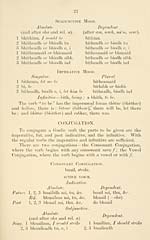Download files
Complete book:
Individual page:
Thumbnail gallery: Grid view | List view

20
Emphatic form X agam-sa a^ad-sa
pi. againn-ne agaibh-se
Aig, ag, ga, at
Ann, na, in
Prepositional Possessives
mo do a t
ga m' ga d' ga ' g
am
na
II ar
THE VERB.
The Gaelic verl) has Voice, Mood, Tense, Nuinher and Person.
It differs from the English and Classical verbs in not havini:- par-
ticiples active, and in having two forms of the Ind. and Subj.
moods, one used when the verb is or can be the very first word in
the sentence, and the other when the verb comes after a particle,
such as the interrogative particles an and nach, the negative
rha, and the conjunctions gun, nach, imi'n, mur, and nan. The
form used after these particles is called the Dependent Form ;
the other is called the Absolute Form. For instance, BuKilidk
mi, I shall strike, becomes, when in the Dependent Form. Am
i>nail mil Shall I strike?
The Gaelic Infinitive is also peculiai- : it is an abstract noun
variously formed by the abstract suffixes -adh.^ -did, -t, -nn, iV'c.
The Verb " to be."
Besides the Absolute and Dependent Forms, the verli "to
be" has also an Assertive or Emphatic Form, viz., is, as, h
gbr '"A if/jw = 'Tis foolish you are : is mi a rinn e = \t was 1 who
di, it.
IxDiCATivE Mood.
Absohitfi.
■.s. 1, 2, 3 tha mi, thu, &c.
Fi(f. 1,2,3 bithidh or bidh
mi, tu, e, &c.
Hel. bhitheas o/- bhios
Pad bha mi, thu. &c.
Dependent.
bheil (* -a for am,
gu iov fjuiii)
( -am)
( - nach, nuir,
chan)
beil
'eil
A--<'rln-(i.
is mi. tu. &c.
i?e^.as(a'i- ,is.o>-'s
De2it. nil
)hi ( - rha)
obh mi, thu, &c.
" The sign
(Am mi
Cha mhi)
bu mhi, tu,
sinn, .sibh
b' e, b' i, b' iad
(as]> I rating
nouns- and
adject treii J
Emphatic form X agam-sa a^ad-sa
pi. againn-ne agaibh-se
Aig, ag, ga, at
Ann, na, in
Prepositional Possessives
mo do a t
ga m' ga d' ga ' g
am
na
II ar
THE VERB.
The Gaelic verl) has Voice, Mood, Tense, Nuinher and Person.
It differs from the English and Classical verbs in not havini:- par-
ticiples active, and in having two forms of the Ind. and Subj.
moods, one used when the verb is or can be the very first word in
the sentence, and the other when the verb comes after a particle,
such as the interrogative particles an and nach, the negative
rha, and the conjunctions gun, nach, imi'n, mur, and nan. The
form used after these particles is called the Dependent Form ;
the other is called the Absolute Form. For instance, BuKilidk
mi, I shall strike, becomes, when in the Dependent Form. Am
i>nail mil Shall I strike?
The Gaelic Infinitive is also peculiai- : it is an abstract noun
variously formed by the abstract suffixes -adh.^ -did, -t, -nn, iV'c.
The Verb " to be."
Besides the Absolute and Dependent Forms, the verli "to
be" has also an Assertive or Emphatic Form, viz., is, as, h
gbr '"A if/jw = 'Tis foolish you are : is mi a rinn e = \t was 1 who
di, it.
IxDiCATivE Mood.
Absohitfi.
■.s. 1, 2, 3 tha mi, thu, &c.
Fi(f. 1,2,3 bithidh or bidh
mi, tu, e, &c.
Hel. bhitheas o/- bhios
Pad bha mi, thu. &c.
Dependent.
bheil (* -a for am,
gu iov fjuiii)
( -am)
( - nach, nuir,
chan)
beil
'eil
A--<'rln-(i.
is mi. tu. &c.
i?e^.as(a'i- ,is.o>-'s
De2it. nil
)hi ( - rha)
obh mi, thu, &c.
" The sign
(Am mi
Cha mhi)
bu mhi, tu,
sinn, .sibh
b' e, b' i, b' iad
(as]> I rating
nouns- and
adject treii J
Set display mode to: Large image | Transcription
Images and transcriptions on this page, including medium image downloads, may be used under the Creative Commons Attribution 4.0 International Licence unless otherwise stated. ![]()
| Early Gaelic Book Collections > Blair Collection > How to learn Gaelic > (30) |
|---|
| Permanent URL | https://digital.nls.uk/79789414 |
|---|
| Description | A selection of books from a collection of more than 500 titles, mostly on religious and literary topics. Also includes some material dealing with other Celtic languages and societies. Collection created towards the end of the 19th century by Lady Evelyn Stewart Murray. |
|---|
| Description | Selected items from five 'Special and Named Printed Collections'. Includes books in Gaelic and other Celtic languages, works about the Gaels, their languages, literature, culture and history. |
|---|

